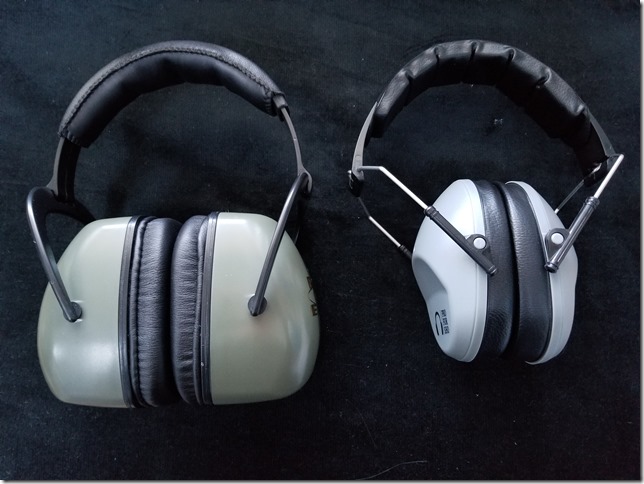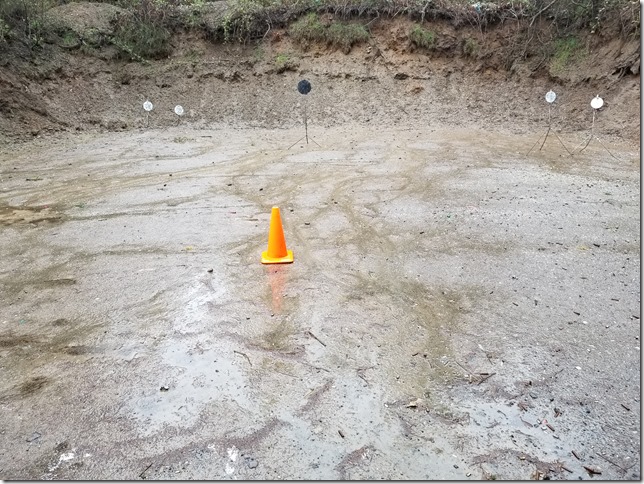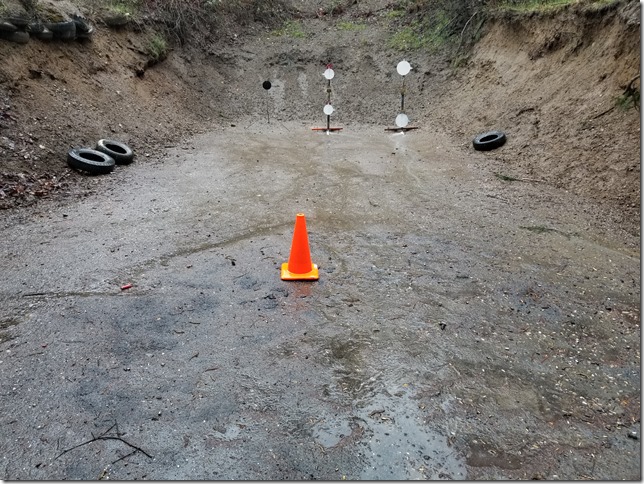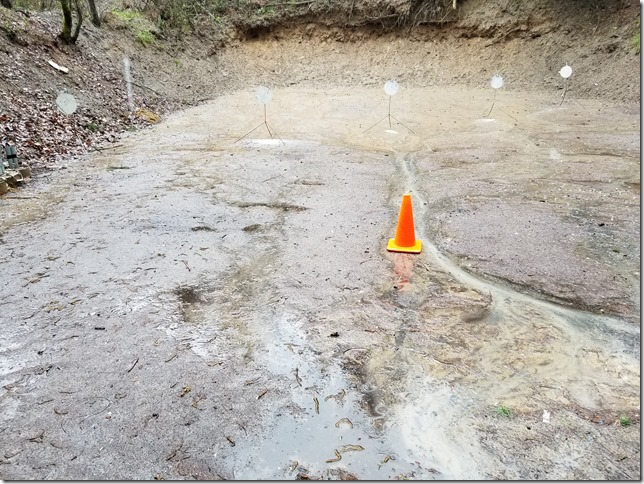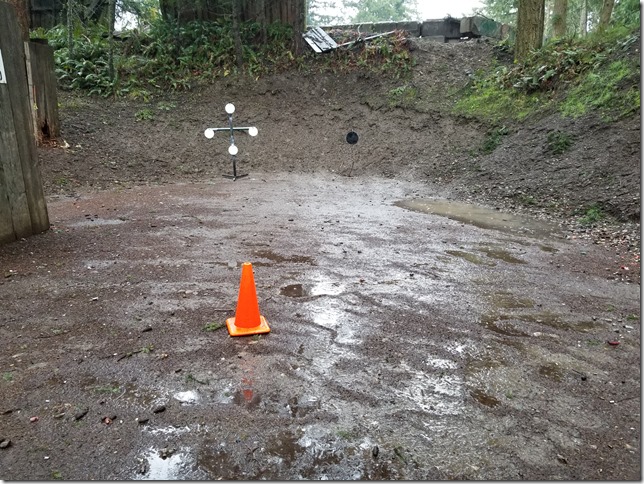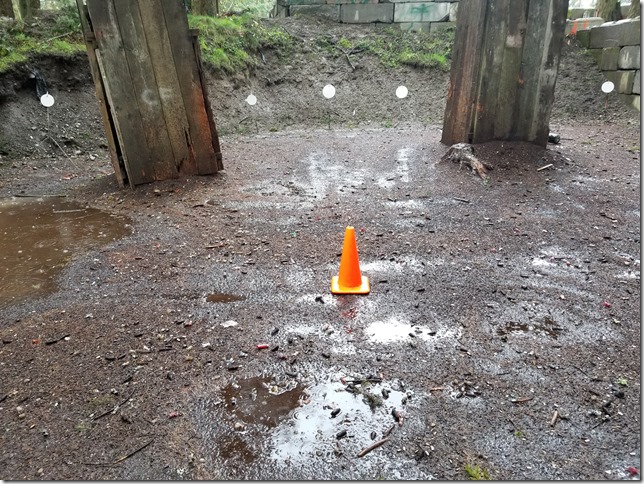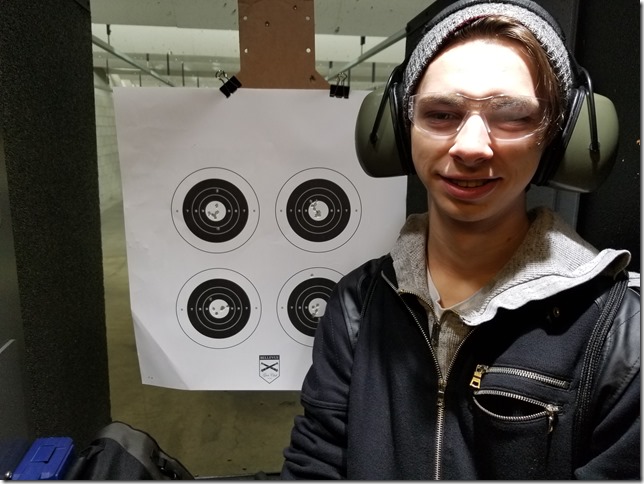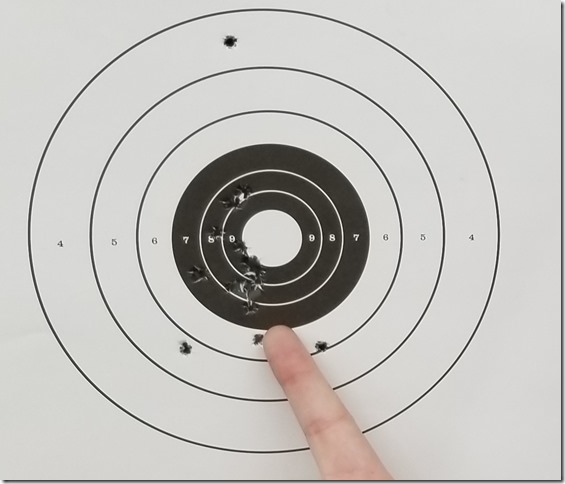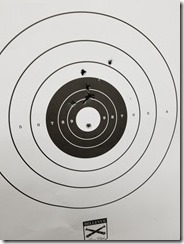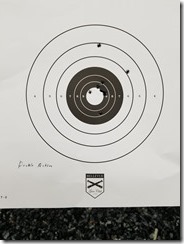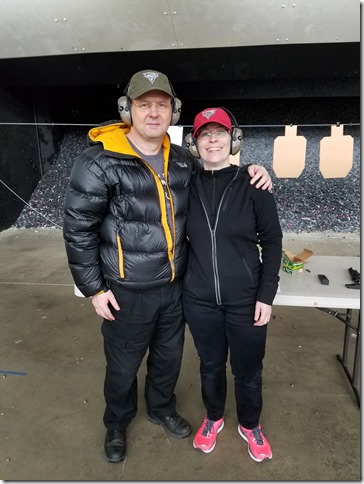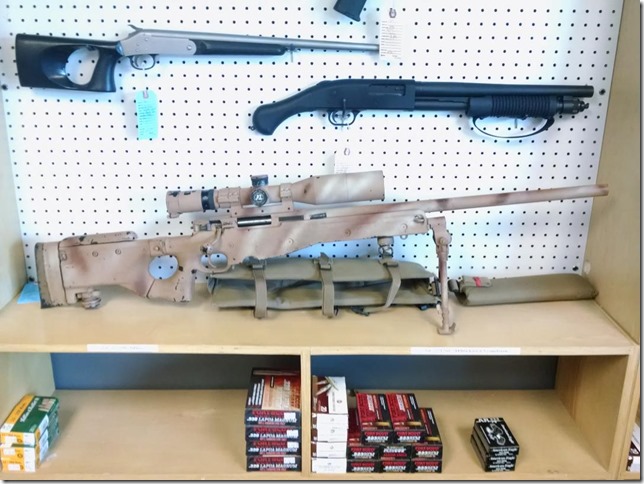It’s only still pictures updated once a minute but you can see what’s happening at Boomershoot today on this web page: http://www.boomershoot.org/Live.htm.
Category Archives: Gun Fun
Pro For Sho ear protection
I recently received an email from Michelle of Pro For Sho asking if I would be interested in reviewing their ear protection.
I expressed my interest because of the mention of rifle shooting and their website was up front about their product being useful for shooting.
I frequently put in plugs rather than try to work around the bulky external muffs required to get good protection. And besides, they are claiming 34db NRR when my go-to muffs for pistol shooting when I am alone (Pro Ears) are at best 30db (title says 30db, but the text of the description says 26db) NRR.
I received them today and tried them on. As I expected, they cannot compare to Pro Ears in the softness of the material around the ears (they are amazing!). But they are better than a lot of muffs I have used and I expect they will be comfortable with the one or two hour sessions I have when using passive muffs.
I put on some loud music with plenty of high frequency content and compare the two sets of muffs. I couldn’t determine which were better.
But, my real test was, “Will they allow me to shoot a rifle?”
Here is a picture of my Pro Ears muffs next to the Pro For Sho muffs:
This is a huge difference in clearance between your head and the rifle stock. I got out my rifle in Bellevue (I have another rifle in Idaho I should try it with as well) with the least clearance. As expected the Pro Ears were being pushed up by the stock. The Pro For Sho muffs just barely touched. It’s a win!
Additional information from Michelle:
I just want to mention, since we keep getting a lot of similar feedback from our customers, I think it’s necessary to point out that due to the High NRR Ratio, if you find the earmuffs a bit snug when you first start using them, it’s totally normal. It will loosen up over time. Please FIRST double check to make sure you fully adjust the length of the earmuffs by sliding the cup up and down to find a better fit.
Just in case the earmuffs are still tight, we always suggest to stretch them to make it more comfortable. If the earmuffs are still tight after you fully adjust it, take the earmuffs out and clamp it over the box and let it sit overnight. It worked great with most of our customers who tried it.
MORE INFO ABOUT OUT PRODUCT (just want to save your from checking other resources online 😉
We have two types/sizes of Pro For Sho Shooting Hearing Protection Earmuffs:
This comes in one size only, which is Standard Size.
This is a more compact sized earmuffs, which is available in 10 different colors.
2. Pro For Sho All Terrain Safety Ear Protection
This comes in Large Size and has an NRR of 32dB.
This was also designed with larger ear cups.
This one is specifically built for larger head size, available only in black color.
I would like to point out that the Small size actually is the Standard size which is designed for a universal fit, and the Large size should be Extra Large size. Since Amazon only offers a very limited option of the Size Variation, we had to use Small and Large instead of Standard and Extra Large. We already tried coordinating with Amazon to address this issue.
Shooting in the rain
Today I participated in a Steel Challenge match at Renton Fish & Game Club. It was a very rainy day and participation was down from normal.
They put up awnings and with rain gear from head to toe I stayed dry. My fingers got a little cold when I was running the scoring tablet or the timer and couldn’t wear my gloves. But I was comfortable enough.
The bays had huge puddles of water in them (or “Almost pond status.”, as Barb described bay 4):
I had a few problems with some of my magazines. Some of the magazines for the Ruger Mark III 22/45 and one of the STI DVC magazines were slow to push the rounds up after the one on top was removed. Two weeks ago I had that problem with the Ruger magazines at Holmes Harbor Rod & Gun Club. I cleaned all the rimfire magazines with an ultrasonic cleaner and lubricated them with a Teflon Non-Stick Dry Film Lubricant. I figured they were all good to go. But they weren’t. And the one STI magazine had the same problem. After the first stage I put all the slow magazines aside and didn’t have any more problems. Those magazine are going to get some special attention from me to make sure they don’t cause problems again.
As I was shooting the match everything felt really slow. I realized the targets were smaller than what we usually have at Holmes Harbor and the spread of the targets was sometimes much larger, but it seemed like I had to really slow down to get consistent hits.
I thought I did okay. I only had one direct competitor in my squad with the centerfire pistol iron sights category. And no competitors with my rim iron sighted gun. Most were shooting open division guns and rifles. So it was a little tough to tell.
Taking into account my equipment problems and things seeming to take longer than they should I was quite surprised to find I won both of my divisions:
| Rimfire Pistol Iron | |||||||||||
| Final | Name | USPSA | Class | Division | Time | Stage 1 | Stage 2 | Stage 3 Focus | Stage 4 | Stage 5 | Stage 6 |
|---|---|---|---|---|---|---|---|---|---|---|---|
| 1 | Huffman, Joe | U | RPI | 117.53 | 22.48 | 17.79 | 19.69 | 16.73 | 18.74 | 22.10 | |
| 2 | Sasaki, Jack | U | RPI | 127.37 | 27.22 | 19.36 | 20.34 | 15.90 | 20.43 | 24.12 | |
| 3 | Schneider, Milton | U | RPI | 148.33 | 26.65 | 22.26 | 22.40 | 27.17 | 22.76 | 27.09 | |
| 4 | Schneider, Jo | U | RPI | 210.86 | 42.19 | 26.95 | 25.16 | 36.52 | 42.06 | 37.98 | |
| Centerfire Pistol Iron | |||||||||||
| Final | Name | USPSA | Class | Division | Time | Stage 1 | Stage 2 | Stage 3 Focus | Stage 4 | Stage 5 | Stage 6 |
|---|---|---|---|---|---|---|---|---|---|---|---|
| 1 | Huffman, Joe | U | CPI | 145.91 | 27.07 | 27.92 | 21.73 | 21.00 | 20.23 | 27.96 | |
| 2 | McClaine, Seth | U | CPI | 200.98 | 45.33 | 28.86 | 30.23 | 28.66 | 34.01 | 33.89 | |
| 3 | Helsen, Mark | U | CPI | 209.69 | 36.04 | 25.00 | 31.52 | 36.88 | 41.91 | 38.34 | |
| 4 | Bell, Richard | U | CPI | 361.17 | 53.43 | 82.47 | 58.15 | 38.96 | 75.79 | 52.37 | |
| 5 | Meboe, Oscar | U | CPI | 366.10 | 65.64 | 40.13 | 48.39 | 65.04 | 74.83 | 72.07 | |
| 6 | Sharpe, HUnter | U | CPI | – | 87.70 | – | – | – | – | – | |
I have never won a match, of any type, at Renton before. It guess it was worth it to shoot in the rain when a lot of the competition was smart enough to stay at home and keep warm and dry.
With six stages and four strings of five shots each this means I averaged 0.979 seconds per shot with rimfire and 1.216 seconds per shot with centerfire. Compare this to the typical times at a Holmes Harbor match of 0.637 seconds per shot and 0.770 seconds per shot. Yes, I actually was shooting a lot slower. And by comparing the pictures of the stages you can see why.
Rounds in the last month
I still did a lot of prepping of .223 brass this month but I also did a fair amount of reloading. I reloaded 1195 rounds of .223. I’m going to do a little more .223 then I have to switch back to .40 S&W as I am running out of practice ammo.
This brings my lifetime reloaded ammunition totals to:
223: 4,513 rounds.
30.06: 756 rounds.
300 WIN: 1,591 rounds.
40 S&W: 80,258 rounds.
45 ACP: 2,007 rounds.
9 mm: 21,641 rounds.
Total: 110,766 rounds.
In somewhat related news a co-worker told everyone at the team meeting today that if there were a zombie apocalypse he was going to find me. As he is about 6’ 6” tall, smart, and regularly practices martial arts I could see there being some potential for their being a mutually beneficial relationship in such an event.
Piper can get away with saying this
I can see this being a valid statement:
While Piper can get away saying this I would never say something like that. I don’t have a cat.
New shooter report
Barb’s son Max, his friend Mikel, and I went to an Airsoft range last Sunday. It was the first time for Mikel and I. I was a little uncomfortable aiming and shooting what looked very much like a real gun at real people. That uncomfortable feeling went away when people started shooting at me. It’s strange how that works. I returned fire and got my share of “kills” and was on the winning side about 70% of the time. It’s not something I would do again on my own, but if someone wanted me to go with them I probably would agree just to be social.
On the way home Mikel asked how the rental Airsoft guns compared to real guns in terms of weight. Max and I told him a little lighter on average and the magazines were much lighter. I followed up with an offer to take him to the range and shoot some real guns if he wanted. He agreed and I was able to get a complete bay to ourselves for Tuesday evening.
I started him out on a .22 pistol with a suppressor. I taught him grip, stance, sight alignment, trigger prep, trigger squeeze, and follow through. Then I had him do dry fire to practice what I had just taught him. Then it was live fire with subsonic ammo. He did well. This is Mikel (with fogged up safety glasses) and his first target after 20 rounds at about five yards:
Next, no suppressor with high velocity ammo. He continued to do well and we moved the target out to about seven yards. His groups opened up some but they were still inside the rings.
I then at five yards had him shoot five rounds as fast as he could shoot while keeping them inside the rings as he rotating around the four targets while on the shot timer. He continued to keep his cool and keep them within the rings even as he shot faster and faster.
Next I got out a .22 revolver and told him this was the lightest gun I owned. And I put my STI Eagle on the bench and told him that was my heaviest handgun. He compared the two and expressed some surprise.
He fired the revolver single action, then double action, and expressed, both verbally and with his group size, a preference for single action.
Next he did some dry fire with the STI Eagle. To my surprise there was a jerk of the gun when he pulled the trigger on an empty gun. I mentioned this and he said he was anticipating what he expected would happen when it was loaded. Max had told him it would have a lot more recoil. Okay then! We’re going to have fun with this!
I had him dry fire until long past the time the flinch was completely gone. Then I put in a loaded magazine (with very low powered .40 S&W loads) and pretended to put a round in the chamber. “Now, shoot just like with the dry fire”, I told him. There was a click and a big flinch. Gotcha!
I again pretended to put a round in the chamber and reminded him, “Trigger prep, sight alignment, squeeze, follow through. Just like with the empty gun.” No flinch. Again an empty chamber. No flinch. Then a loaded chamber. The bullet went into the bottom of the bullseye at five yards. Again and again he shot. 18 rounds and all near the bottom of the bull into about a 1.5 inch group. Nice. Another 18 rounds in the next target. And again, good shooting. I asked him to remember what his target looked like and I took him to another bay where people were shooting and showed him the targets people were shooting as well as the targets in the garbage cans. Most of them had such a wide pattern there wasn’t even a hint of a group near the rings.
Then I gave him Major Power Factor loads with two of the light loads on the top of the magazine so he could compare the easily. I could hear a significant difference as well as see the increased recoil from the heavier loads. He still kept the rounds on target with only an occasional stray out of the black.
“Okay, now what do you want to do?” I asked. “You can do more handgun shooting of whatever gun you want or you can shoot the AR-15s”, I told him. He was unsure. I then offered to set up multiple targets where he could move and shoot with the handgun. He lit up at this and so we put out five USPSA targets at various distances. I started him about five yards from the closest target, the second to the right at about 10 yards, and the remaining three to the right of that at about 15 yards from his starting position. I told him to start at the low ready, go slow, be safe, put two rounds on each target, move and shoot however he thought would be best to get almost all A-zone hits. He did great on the safety issue and I told him to go a little faster if he wanted. I think he shot the stage four times getting his time down into the 17 second range with reasonable hits most of the time.
Max then shot the stage a few times. Good hits with times in the 15 second range.
They asked if I wanted to shoot it so I shot it two different ways. The first was without moving. Just shooting all the targets from the start position. Something over seven seconds with five A-zone hits and five C-zone hits. The second attempt was while moving and shooting with me ending up about three feet from the last few targets. My time was in the fives with seven A-zone hits and three C-zone hits. They seemed to be impressed.
We cleaned up the range, packed up, washed up, and went outside to talk for a while. I told Mikel the five shots on five targets was practice for steel challenge events and that if he wanted he could shoot that type of match now with his skill set and not be embarrassed. I explained that it is difficult to do extremely well, but it’s easy to “Not suck”. I then told him about a couple flavors of action shooting. I described the problem solving and difficult shooting positions. And to just let me know if he wanted to go shooting again or shoot in a match.
He seemed very enthusiastic and thanked me. In my mind, I was thanking him for giving me an opportunity to bring another person onto our team.
Ballistic gel tests
I received an email from Brandon B. of Ammunition To Go about a bunch of ballistic gel tests they recently completed. Nearly 100 different handgun loads were tested. See Self Defense Ammunition Ballistic Test for the overview. There are links there to the individual tests but here are the shortcuts to each of the calibers tested:
- 380 Auto Ballistic Test Results
- 9mm Ballistic Test Results
- .40S&W Ballistic Test Results
- 45ACP Ballistic Test Results
There were some interesting results in there. I have a probably 400 hundred rounds of some cheap .40 S&W JHP I bought years ago that I thought might use as carry ammo.
And I did use it as carry for a while. But it sort of bothered me that I didn’t have any data to support it being “high quality”. After a year or so I paid about twice as much per round for other ammo that I knew was used by many law enforcement agencies. I have continued that practice ever since. I don’t always buy the same ammo as the previous time, but I always buy something which has been tested and found to work well with the FBI standardized tests. Yes, the FBI tests have some flaws, but if a cartridge performs well in the FBI tests it isn’t likely to be a failure if I ever need “stopping power” in real life.
So, I looked up the cheap ammo in the test results. It did not do well. I might as well use it for practice, reload the brass, and use the shelf space for something else.
The ammo I have more recently purchased did much better.
Last call for Boomershoot Precision Rifle Clinic
The Boomershoot Precision Rifle Clinic put on by Eugene Econ and his staff has been a part of Boomershoot since 1999. Yesterday I received an email from Eugene stating that this will be his last year. It’s possible someone else will pick up the “baton” but that is unknown at this time. This may be your last chance to get some outstanding instruction for an incredible price with the opportunity to follow it up with practicing your newly acquired skills with hundreds of highly reactive targets the very next day.
You need to make your decision soon because Eugene also asked that Precision Rifle Clinic registration be cutoff on April 1 this year. This is due to the logistics of getting enough staff for the clinic participants.
Sign up NOW for Boomershoot 2018 and the Precision Rifle Clinic.
Also, of possible interest to previous participants is, the “gravel” driveway has been refurbished. You can now easily drive your low clearance vehicle all the way in without fear of banging up the underside or the need of a snorkel to get through the mud holes. See the before and after pictures to get a sense of the improvement.
What is Boomershoot? Boomershoot is a long range, high-power, precision rifle shooting event with high explosive, reactive targets up to 700 yards away.
I’m getting the hang of this
I shot in another Action Shooting International match yesterday. While the game could be described as an extremely simplified version of USPSA the game is scored much differently than USPSA:
ASI matches use the popular “time and penalties” scoring system. The elapsed time from the first shot to last is the shooter’s raw score, plus any applicable penalties. Matches will use the standard IDPA target. (Although USPSA/IPSC targets may be used in a pinch.)
3.1 Each paper target must be shot twice, unless indicated in the written course description. If the shooter fires more shots at the target than needed, only the best-scoring shots will score (typically the best two).
3.2 Shots striking the central scoring zone do not incur a penalty. Shots striking outside the central scoring zone earn time penalties in seconds, according to the following rule:
IDPA Target – “Down Zero” = +0, “Down 1” = +1 second, “Down 3” = +3 seconds.
USPSA/IPSC “Metric” Target – “A” or “B” = +0, “C” = +1 second, “D” = +3 seconds.
USPSA/IPSC “Classic” Target (international) – “A” = +0, “C” = +1 second, “D” = +3 seconds
The IPDA “Down Zero” area is much smaller than the USPSA “A” zone. I typically shoot USPSA targets with splits in the range of 0.20 to 0.50 seconds where a few “C” hits aren’t a big deal. This isn’t the case with ASI matches. First off, I must slow down just because of the much smaller “Down Zero” target area. And then I have to keep in mind that I can easily double the amount of time per shot and still end up with a better score because of the severe penalties of a non perfect hit. My habit, from years of USPSA shooting, is to shoot like I had the USPSA “A” zones and shoot where a few “C” hits don’t matter.
I slowed down a lot and got much better hits. It was not enough because I still had eight seconds of penalties with a seven stage match. But compared to nine seconds for a five stage match last month it was a big improvement. The standing reflected this improvement as I came in fifth out of 75 shooters this time as opposed to ninth out of 58 at the last match.
Rounds in the last month
This month I only loaded a 180 .223 rounds. Part of that was because I spend a long weekend visiting Xenia in Kentucky and part is because I finished up most of my new .223 brass and started in on my used brass. The used brass needs more prep and with my hand powered tools it took a lot of time. The new electrically powered tool helped a bunch and I have been been prepping brass and, essentially, not reloading as I go through the backlog of used brass to clean and prep.
This brings my lifetime reloaded ammunition totals to:
223: 3,318 rounds.
30.06: 756 rounds.
300 WIN: 1,591 rounds.
40 S&W: 80,258 rounds.
45 ACP: 2,007 rounds.
9 mm: 21,641 rounds.
Total: 109,571 rounds.
Rifle brass prep
I decided to use up a bunch of the rifle reloading components I have laying around and quickly found I was spending way more time than I wanted. Using hand powered tools trimming the brass to length and cleaning the primer pockets was taking, on average, about a full minute for each round. Also, my hands ached after about 100 rounds and I would have let them recover for an hour or more before continuing. With many thousands of rounds in my immediate future I decided I needed another solution.
I purchased the Frankford Arsenal Platinum Series Case Trim and Prep System (see video at the link):

This cut the one minute down to about 15 seconds. I can still get an ache in my hands if I’m not careful to mostly press the brass when trimming rather than trying to grip it tightly. But if I pay a little bit of attention it hasn’t been a major problem.
I have processed over 1000 rounds with it now now I am very pleased.
New shooter report
Kelsey recently joined my team at work. Like Caity, when she first joined the team full time, there was a minor flaw. Everyone else on our team knows how to shoot and enjoys guns. Kelsey is very quiet and difficult for me to read. I wasn’t sure whether to discuss this issue with her or not. Over the course of a few weeks it came out that she was interested in learning to shoot so I reserved the training bay for 12:00 –> 2:00 (they only do two hour blocks) today. It turned out our boss gave us all the afternoon off since we have to work part of Sunday this weekend so Kelsey and I weren’t rushed when we visited the range.
I started her out with a suppressed Ruger Mark III 22/45 with subsonic ammo at five yards.
That went well. I didn’t take a picture of the target after the first eight shots, but here you can see the target after 18 rounds:
The first eight shots were the three at the bottom, and then a vertical hole of five shots you could cover with a nickel. The one wild shot at the top was near the end of the second magazine.
I had forgotten to tell her to keep the front sight in focus. We talked about that a bit and then she went on to a .22 revolver. I had her fire it single action with CCI CBs:
That went well:
Okay, now a challenge, and the reason I seldom recommend revolvers. Shooting a revolver in double action mode:
Again, a couple wild shots near the end of the string. But the rest of the shots are really rocking it for a new shooter with any handgun, let alone a double action revolver. She learns fast!
I gave her a choice, learning to shoot faster, move to a larger caliber gun, or more precision shooting with the Ruger. She choose more precision shooting with the semi-auto.
I was amazed. This is 10 rounds at five yards:
These were shots 37 through 46 in her entire life. She only once even held a gun in her hands before (so she says).
This is after 20 rounds:
Okay. She’s a pro. There is nothing I can teach her about this type of shooting. We have to move on to something else. She is going to get bored putting so many bullets through a single hole.
I put up a paper with four bull’s-eye targets and told her to put one round on each bullseye. Keep it in the black or smaller, but shoot faster. She did a couple strings of five shots each. She shot quite a bit faster, but about half the bullets were in the 10 ring.
Uhh… nice.
I told her she can go faster still, “Just keep them in the black. As soon as the sights are lined up somewhere within the black, squeeze off the last 20% of the trigger pull”. “Oh”, she replied, “I can do that.” And she did. Hmm… I need to push her more.
I pulled out the shot timer and went through the range commands with her: “1) Make ready. 2) Are you ready? 3) Standby…BEEP!” Got that? Good. Let’s try it.
And I finally pushed her into failure. With four shots, one bullet barely nicked the bottom of the paper, and one missed on the right side of the paper entirely. Ah! Now we have something I can teach her!
Shooting fast, particularly in competition, is a mind game. A little bit of stress can make everything fall apart. Don’t let the timer or the shooter next to you, with their own set of plates competing for the first to complete, affect how you shoot. You shoot your targets your way, just like you did in practice. Let’s try it again.
She got it. From the low ready she was able to get five shots into five targets (one of the targets twice) in six point something seconds. All her splits were less than a second.
We had used up all our range time so we cleaned up the range and as we returned to the lobby to wash up I asked her to walk slowly past the shooters in the next bay and look at the targets the other shooters were producing. I told her, “There won’t be any targets even close to what you did today”. I was right. There wasn’t a pattern on any of the targets I could have completely covered with both of my hands spread wide.
We went on to the lobby and I finished washing first. I grabbed her 20 round target and showed it to the range officer behind the counter. She was as amazed as I was and pulled up Kelsey’s profile in their database and made a note of something about “A legend has been reborn.”
Kelsey earned her new shooter smile and she is now a complete member of our team:
Rounds in the last month
The only caliber I reloaded this month was .223. I reloaded 418 rounds.
It was slow going with a lot of case prep on the used brass. I also loaded up a few test rounds of some new bullets. These were Berger 75 and 80 grain VLDs, and the Berger 82 grain Long Range BT. With my target AR I get good results with factory ammo with 77 grain Sierra Match Kings but the Berger’s have higher ballistic coefficients and if I get as good as accuracy from them as the factory ammo and the expected velocities then I will have more wind resistant ammo than the factory loadings. The problem with the two heavier bullets is they take up so much space that if you load them to max over all length you can’t get as much powder in the case as you can if you load them to significantly over the max overall length. But if you load them over length then you have to feed them into the chamber one at a time by hand because they won’t fit in the magazine.
I decided to load my test round to spec with reduced charges and see what I end up with. I’m expecting it will be disappointing. I’m more excited about the 75 grain VLDs. They have a G1 BC of .421 compared to the 77 grain Sierra Match King’s .362. That’s significant. And with a slightly lighter bullet I might be able to get a little higher velocity as well.
I haven’t fired any of them yet. I’m going to wait until I go to Idaho again so I can do some accuracy testing at the same time as the chronograph tests at about 200 yards.
This brings my lifetime reloaded ammunition totals to:
223: 3,138 rounds.
30.06: 756 rounds.
300 WIN: 1,591 rounds.
40 S&W: 80,258 rounds.
45 ACP: 2,007 rounds.
9 mm: 21,641 rounds.
Total: 109,391 rounds.
Replacing a fiber optic front sight
I was looking at the latest issue of USPSA FrontSight Magazine last night and found that 93% (IIRC) of the Limited class shooters at nationals this year used guns with fiber optic inserts in their front sights.
Son-in-law John (and USPSA grandmaster) works for Shooters Connection. Here he shows how to replace a fiber optic insert:
Shooter report
Paul and Louise visited us from Canada this weekend. Paul was in the U.K. military and had a fair amount of experience with rifles but very little experience with handguns. Recently they purchased handguns and took some classes. Then Paul decided he would like to get into reloading. I showed them my reloading set up and talked quite a bit about it with them. Why I reload, some tips on reloading he probably won’t find in the YouTube videos, and why I have some of the equipment.
Barb and I took them to the range and Paul had his first experience shooting an AR and Louise shot a rifle for the first time. Among other firsts were shooting a gun with a suppressor.
I did a little coaching with Louise but Paul was doing very well without much input from me. We probably went through about 400 rounds total of .22LR and .40 S&W. It was a good day and you can see the indicator of that with the new shooter smile on Louise’s face.
Rifle for sale
I’m not looking for a rifle like this, but maybe someone else is. Boomershoot is coming up very soon!
From Richard:
I have been following your blog, The View from North Central Idaho for some time. Getting to Boomershoot is definitely on my bucket list!
I wanted to make you aware of an interesting rifle being sold by a friend of mine.
For Sale from original user:
Accuracy International Sniper Rifle in .308
Field tested in the sandbox
Includes original logbook with photos of test results. Must sign a non-disclosure to receive the logbook.
Certificate of Authenticity from Craft International.
Asking $12,000.00The user convinced AI to buyback the rifle from his unit and then sell it to him.
Please contact me if you or anyone you know has a serious interest.
If you are interested send me an email and I’ll forward it on.
Detonating Boomerite with a pistol
We have long known that Boomerite detonates at lower velocities if the bullet has a flatter tip. But we have never had reliable detonation with a pistol. As I reported a few days ago I made up some 145 grain loads for my .40 S&W gun. I bought the bullets 10 to 15 years ago just for this but I it wasn’t until now that I finally got around to loading them for Boomerite testing. With a near maximum load I get just over 1400 fps at the muzzle. The truncated cone bullets have a pretty wide flat area:
I visited Boomershoot last weekend and among other things I mixed up a batch of Boomerite and tested the hot 145 grain loads. With the weather being a little cold, 34 F, I expected I would have to be pretty close to get detonation. And maybe I wouldn’t be able to get detonation at any safe distance. I put on my flak jacket, eye protection, ear protection, and got back 15 yards. This should be a target velocity of about 1330 fps. I squeezed off a shot—BOOM! Okay, that worked.
How about 25 yards? That would result in about 1280 fps at the target. Another squeeze yielded another earth shaking boom from a seven inch target. Okay then. It’s good enough.
This means I can use my handgun for Boomershoot cleanup if I want to.
Quote of the day—Caity
You are so quiet.
Except when you are blowing up stuff.
Caity
January 4, 2018
[Caity is a co-worker. She was in the kitchen filling a container with filtered water when I came in to get a cup of tea. She apparently didn’t hear me as I walked up behind her.
I do frequently try to walk in such a way that my upper body is a stable shooting platform. It’s not as exaggerated as when I’m actually shooting a USPSA match, but it does tend to cut down on the noise.—Joe]
That’s what I carry
This is kinda cool. FBI Selects Winchester’s .40 S&W Ammunition for Duty and Training:
The Federal Bureau of Investigation (FBI) has completed an extensive evaluation process and Winchester has been chosen as its primary source for .40 S&W pistol ammunition. This includes a bonded jacketed hollow point (JHP) service cartridge as well as full metal jacket (FMJ) and frangible training loads. Winchester has been supplying the FBI with service and training ammunition for many years and is honored to be awarded the most recent contract and continue to support our nation’s premier law enforcement agency.
The 180 gr. bonded jacketed hollow point (JHP) cartridge selected by the FBI is designed with patented technology that utilizes a reverse-jacketed, bonded bullet that can penetrate a wide variety of intermediate barriers while maintaining very consistent target penetration and reliable expansion. The nickel-plated cartridge prevents corrosion and ensures smooth feeding and extraction. Flash suppressed powder is used in this cartridge to maintain an agent’s night vision and meet the FBI’s stringent darkened range evaluation.
The Winchester .40 S&W, 180 grain, JHP cartridge (Ranger) is my carry ammo.
Update: In the comments John Hardin asked if the FBI chose the Ranger bullets. I think the answer is yes. As near as I can tell the “reverse-jacketed” bullet refers to their patented reverse taper (thick near the opening, thinner on the sides and base) JHP with with the jacket pre-scored in the area intended to expand. This gives the uniform size and characteristic hooks at the end of the “petals”:
Winchester sells several different 40 S&W 180 grain JHP cartridges. Two of them appear to use the same bullet, the W40SWD and S40SWPDB1 cartridges. A third, USA40JHP, appears to be using a conventionally jacketed bullet:
There are also what appear to be different brandings, and/or nickel plated brass casings, of these same three cartridges:
So, I believe the FBI must have chosen a cartridge with the same bullet as what is in the Ranger bonded cartridge.
Quote of the day—Tom Knighton
I’ll consider it my sacred duty to create as much spent brass as humanly possible.
You know, for the children.
Tom Knighton
January 2, 2017
Are Ammo Prices Ready To Drop?
In regards to concerns that some ammunition manufactures are having financial stress because of a lower ammunition prices.
[There are other options available as well. Teach your child to shoot, and/or send them to a shooting class, and buy them all the ammunition they can consume. I’ve been giving my kids reloaded ammunition tailored for their specific usage. And Santa stuffed at least one stocking with ammunition last year.—Joe]

